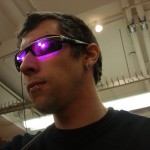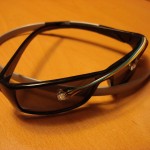 This project aims to explore synesthesia by associating certain body positions with visual hallucinations induced by photic stimulation. In other words, flashing lights at various frequencies seems to cause visual patterns to appear for the viewer. Simple wearable sensors will adjust the frequency of the flashes and thus provide various patterns. Although the patterns may differ for each viewer, they seem to be the same for the viewer at a given frequency.
This project aims to explore synesthesia by associating certain body positions with visual hallucinations induced by photic stimulation. In other words, flashing lights at various frequencies seems to cause visual patterns to appear for the viewer. Simple wearable sensors will adjust the frequency of the flashes and thus provide various patterns. Although the patterns may differ for each viewer, they seem to be the same for the viewer at a given frequency.
Much of this project stems from two separate influences. First, William Gibson’s “Neuromancer” where he depicts the protagonist using electrodes/glasses to jack into cyberspace, which is depicted as a three-dimensional space largely visualized as colored geometric shapes. Secondly, my general jealousy of individuals whom describe themselves as synesthetes, those who experience certain senses crossing over, ie. seeing certain letters as colored or hearing certain visual motion.
An article in the journal Cortex (#44, May 2008, Dominic H. ffytche), describes a study which employed flashing goggles to induce visual hallucinations for the purpose of analyzing brain activity with MRI. The study indicates that flashing frequencies between 5-30Hz at a certain intensity caused participants to describe perceiving hallucinations (Purkinje patterns) and produced a measurable change in the brain activity.
I’d like to use this visual stimulation to represent a small portion of our sense of proprioception. The ideal scenario would be to enable a user to generate an association between certain Purkinje patterns and the orientation of the body relative to itself. I’m working closely with Andrew Styer on the input devices and we’ve been discussing the best sensing for our end. Trying to visualize all of proprioception in this manner would be arrogant at best, so for this prototype we are looking to limit our focus to the upper body, possibly the arms alone.
Initial user testing of the glasses have provided strong reactions and most participants report perceiving patterns which change in response to frequency shift. Participants generally indicate that the experience is pleasant, however the prototype glasses may provide too much illumination intensity, overpowering the effect.
Next steps are to experiment with various sensors / inputs and to determine the levels of discernible patterns within the available frequency range. Another direction for exploration is the event as frequencies change. Several participants have expressed strong reactions when the patterns initially change. Perhaps alternating between frequencies could provide another dimension to the expressiveness of the glasses.
I was first introduced to this visual effect by Mitch Altman’s Sound and Light Machine (aka. the Brainwave Glasses) as described in Make zine. My first electronics kit was hacking Adafruit’s MiniPOV kit to make the glasses.
Leave a Reply
You must be logged in to post a comment.